1. Component views
EGR cooler bypass valve
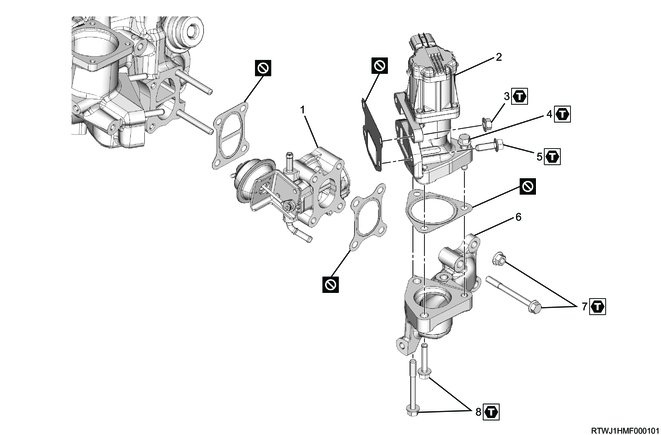
Part name
- EGR cooler bypass valve
- EGR valve
- Nut
- Bolt
- Bolt
- EGR valve adapter
- Nut and bolt
- Bolt
Tightening torque
3: 25 N・m { 2.5 kgf・m / 18 lb・ft }
4: 25 N・m { 2.5 kgf・m / 18 lb・ft }
5: 25 N・m { 2.5 kgf・m / 18 lb・ft }
7: 25 N・m { 2.5 kgf・m / 18 lb・ft }
8: 25 N・m { 2.5 kgf・m / 18 lb・ft }
2. EGR cooler bypass valve installation
1) Install the EGR cooler bypass valve water return hose to the EGR bypass valve.
2) Apply engine oil to the threaded portions of the sleeve nuts on the injector side, as well as the injector O-rings.
3) Temporarily tighten injection pipe No. 4 to the common rail (fuel rail) and injector by hand until the sleeve nut can no longer turn.
Caution
- Do not reuse the injection pipe.
4) Temporarily tighten the clips to injection pipe No. 3 and No. 4.
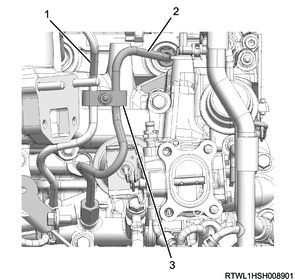
Legend
- Injection pipe No. 3
- Injection pipe No. 4
- Clip
5) Final tighten injection pipe No. 4 to the injector and common rail (fuel rail).
Tightening torque: 44 N・m { 4.5 kgf・m / 32 lb・ft } Injector side
Tightening torque: 44 N・m { 4.5 kgf・m / 32 lb・ft } Common rail (fuel rail) side
6) Final tighten the clips to injection pipe No. 3 and No. 4.
Tightening torque: 8.0 N・m { 0.8 kgf・m / 71 lb・in }
7) Temporarily tighten the EGR valve and gasket to the inlet manifold.
Caution
- Do not reuse the gasket.
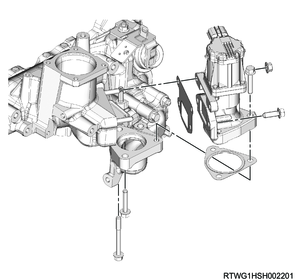
8) Temporarily tighten the EGR valve adapter and EGR cooler bypass valve as a set to the EGR valve.
Caution
- Do not reuse the gasket.
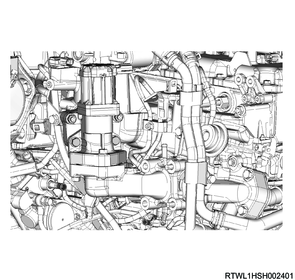
9) Temporarily tighten the EGR valve adapter to the inlet manifold.
Caution
- Do not reuse the gasket.
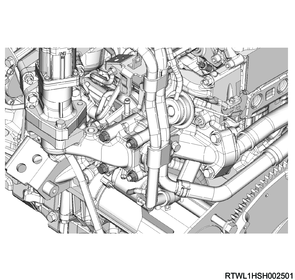
10) Final tighten the EGR valve to the inlet manifold in the order shown in the diagram.
Tightening torque: 25 N・m { 2.5 kgf・m / 18 lb・ft }
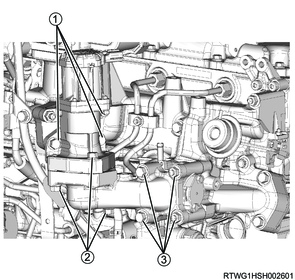
11) Connect the EGR cooler bypass valve water return hose to the heater pipe.
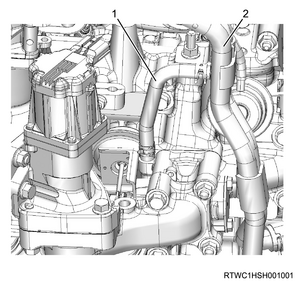
Legend
- EGR cooler bypass valve water return hose
- Heater pipe
12) Install the bracket to the inlet manifold.
Tightening torque: 25 N・m { 2.5 kgf・m / 18 lb・ft }
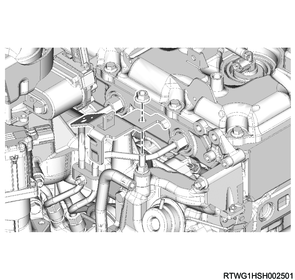
13) Connect the EGR cooler bypass valve vacuum hose to the EGR cooler bypass valve.
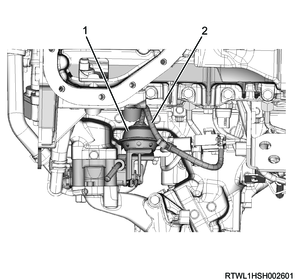
Legend
- EGR cooler bypass valve
- EGR cooler bypass valve vacuum hose
14) Connect the heater hose to the heater pipe.
15) Connect the EGR cooler bypass valve water feed hose to the EGR cooler bypass valve.
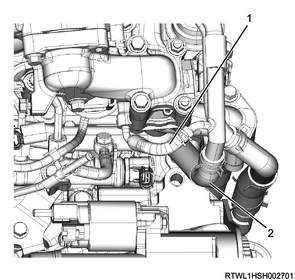
Legend
- EGR cooler bypass valve cooler water feed hose
- Heater hose
16) Connect the heater hose to the heater pipe.
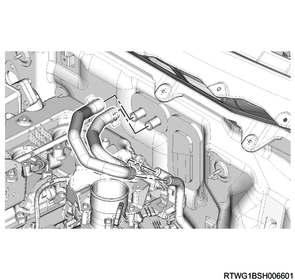
17) Connect the connector to EGR gas temperature sensor 2 (EGR valve side).
18) Connect the connector to the EGR valve.
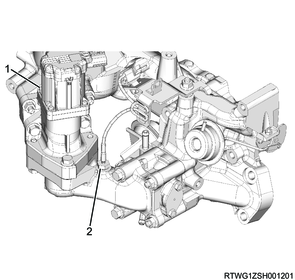
Legend
- EGR valve
- EGR gas temperature sensor 2 (EGR valve side)
3. Starter motor installation
4. Underguard installation
5. Preliminary and post procedures
1. Post procedures
1) Lower the vehicle.
2) Connect the battery cable to the battery negative terminal.
3) Referring to the following, perform the setting of the front door power window switch with AUTO UP/AUTO DOWN function.
Refer to "9.Body, Cab, Accessories 9T.Glass, Windows, Mirrors front door power window switch setting".
4) Close the engine hood.
6. Coolant filling
1) Fill with engine coolant up to the radiator filler neck.
Note
- Fill with engine coolant of the specified concentration to the brim of the radiator cap inlet.
Caution
- Fill slowly to prevent air from entering the system.
2) While pressing the radiator upper hose manually several times to bleed the air from the hose, fill the radiator with engine coolant.
Note
- Fill with engine coolant up to the brim of the radiator cap inlet with the amount the engine coolant lowers.
Caution
- Repeat the operation until the coolant level no longer drops.
3) Add engine coolant up to the MAX line of the radiator reserve tank.
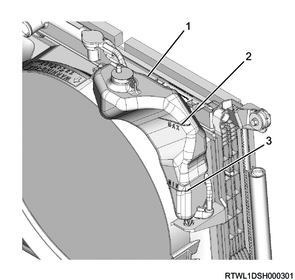
Legend
- Radiator reserve tank
- MAX line
- MIN line
4) Install the radiator cap to the radiator.
5) Start and idle the engine.
Caution
- Idle the engine for 5 minutes or more.
6) Stop the engine.
7) Remove the radiator cap from the radiator.
Warning
- Do not loosen the radiator cap or reserve tank cap when coolant is hot, as doing so may result in burns caused by the release of steam or hot water.
- When opening the radiator cap, cover the cap with a thick cloth once the engine coolant has cooled and slowly turn to release pressure.
8) Fill with engine coolant up to the radiator filler neck.
Note
- If the engine coolant is excessively low, inspect for engine coolant leakage from the cooling system.
9) Install the radiator cap to the radiator.
10) Start the engine.
11) Increase the engine speed to around 2000 rpm and run the engine for 10 minutes once the engine coolant temperature gauge reaches the center.
12) With the engine running, check that the thermostat valve is open.
Note
- Touch the radiator upper hose, and confirm that it has become warm.
- If it has not become warm, go back to Step 11.
Caution
- Do not try determining it by using only an engine coolant temperature gauge.
13) Idle the engine for 5 minutes.
14) Stop the engine.
15) Remove the radiator cap from the radiator.
Warning
- Do not loosen the radiator cap or reserve tank cap when coolant is hot, as doing so may result in burns caused by the release of steam or hot water.
- When opening the radiator cap, cover the cap with a thick cloth once the engine coolant has cooled and slowly turn to release pressure.
16) Fill with engine coolant up to the radiator filler neck.
Note
- Fill with engine coolant of the specified concentration to the brim of the radiator cap inlet.
17) Add engine coolant up to the MAX line of the radiator reserve tank.
18) Install the radiator cap to the radiator.
19) Repeat steps 10 to 18 until the coolant level no longer lowers.
Caution
- If the level of the radiator reserve tank has fallen the next morning, add up to the MAX line.